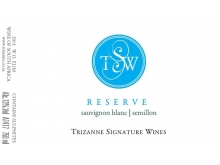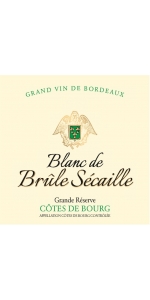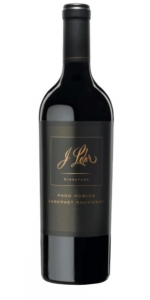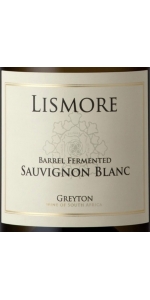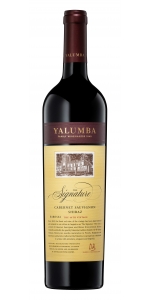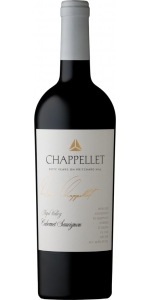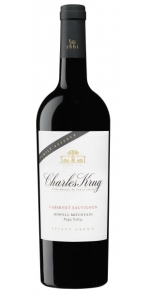Trizanne Signature Wines Sauvignon Blanc Semillon Reserve 2015
| Country: | South Africa |
| Region: | Elim |
| Winery: | Indwe |
| Grape Types: | Semillion Sauvignon Blanc |
| Organic: | Yes |
| Vintage: | 2015 |
| Bottle Size: | 750 ml |
Brulesecaille Blanc Grande Reserve is made from 75% Sauvignon Blanc, 25% Sauvignon Gris.
Average age of the vines is 25 years.
Manual harvest from September 19th-20th 2016.
Direct press at low pressure (whole cluster) with low amount of SO2, settling at 10°C.
Addition of yeast and alcoholic fermentation in casks 400 liters.
Raised on the lees for 6 months with regular batonnage (stirring of the lees).
Bottling in april 2017.
Fish, seafood, white meats, fine goat cheeses.
J Lohr Signature Paso Robles Cabernet Sauvignon is made from 80% Cabernet Sauvignon 6% Cabernet Franc 6% Saint Macaire 4% Petit Verdot 4% Malbec.
J. Lohr Signature Cabernet Sauvignon was first produced to honor the 80th birthday of founder Jerry Lohr. This limited release was specially selected and blended from the exceptional 2016 vintage in Paso Robles. It is both a tribute to Jerry's pioneering efforts in the region and our red wine portfolio's ultimate expression of Cabernet Sauvignon. VINEYARDS & CELLAR Beck Vineyard, in the Creston District of Paso Robles, is a unique, high elevation site that sits at 1,700 feet above the early morning fog line. Its calcareous soils and cooling afternoon winds are perfect for growing Cabernet Sauvignon. The Cabernet from this vineyard ripens early with excellent color, purity of fruit, and phenolic maturity. Incorporation of Cabernet Franc brings freshness to the blend, while the rare Bordeaux variety, Saint Macaire, brings density and a savory character. Petit Verdot and Malbec add structure, color, and a component of bright fruit. The hand-harvested grapes were held separate at harvest and berry-sorted into six-ton open top tanks for fermentation. Maceration took place on the skins for five days, before early pressing to achieve ideal tannin extraction. Aged 19 months in 100% new French oak from coopers Nadalie and Sylvain.
Review:
The nose on this luxury-level bottling is pure and refreshing, offering aromas of black cherry, loamy soil, dried mint and caramel-laced coffee. The palate is framed by upright tannins, yet is soft enough to enjoy now, showing deep flavors of black currant, dried herb, milk chocolate and toffee. Drink 2020–2040.
-Wine Enthusiast 95 Points
Lismore Barrel Fermented Sauvignon Blanc is made from 100 percent Sauvignon Blanc.
As with all Lismore wines, balance is the key. The bracing acidity that is customary in new world Sauvignons has been brought into balance with a carefully chosen pick date and the barrel and egg fermentation and maturation. A full bodied, balanced wine was the goal.
Barrel fermentation and extended lees contact contribute to this full bodied, elegant and well balanced wine. Floral notes of passion flower and fynbos, granadilla, guava, gooseberry and pear on the palate along with an underlying minerality which gives this unique terroir driven wine its signature.
Wine Made in the Soil
The grapes come from 50% Lismore’s Greyton vineyards which are planted on East/Southeast facing slopes at 320 meters in the foothills of the Sonderend Mountain Range. The soils are deep decomposed shale. The other 50% comes from a vineyard in Stanford which overlooks Walker Bay on sandstone soils.
Yalumba The Signature Cabernet Sauvignon Shiraz is made from 54% Cabernet Sauvignon, 46% Shiraz.
Encompassing everything the Hill-Smith family stands for and the perfect representation of Yalumba’s history and ethos, The Signature is a sentimental favorite. A classic Australian blend of Cabernet Sauvignon and Shiraz, the first vintage release of The Signature was in 1962. Since then, this outstanding wine has acknowledged more than 57 Signatories; people who have enhanced the traditions and culture of Yalumba.
Seductive and alluring florals, cool mints, red pomegranate with fine blackberry fruits and dark cherry aromas. The palate is delightfully generous with dark red cherry fruit that merges into ironstone tannins. A medium to full bodied wine with a long, flowing tannin profile.
Review:
The 2018 The Signature Cabernet Sauvignon Shiraz (the 48th vintage) is named for Nick Waterman (managing director and CEO of Yalumba 2015 - 2022). The 2018 vintage in South Australia (and specifically here, Barossa) was an excellent one: ripe/warm, even and long and produced wines with density, energy and gravitas. This is exactly that: plush and powerful. The fruit forms a perfect dovetail: the enveloping, mouth-filling abundance of the Shiraz, neatly wedged into the folds of the structuring and shapely Cabernet. Very impressive. This is one of the more impressive Signatures in recent times. It will cellar with grace and ease.
-Robert Parker 96 Points
Since its first release in 1962, The Signature has been Yalumba's deep dive into the classic Australian blend from the Barossa and one that honors the people who have enhanced the traditions and culture of Yalumba. There is a resonance and depth to this release that I really like. Wonderfully pure and concentrated blackberry and plum fruits, layered with spice, dark chocolate, earth, cedar and oak nuance. Succulent and sinewy in the mouth, it flexes considerable muscle, yet remains purely fruited and approachable even at this stage of its evolution. Rich and balanced with fine, ripe tannin and plenty of energy for such depth of fruit. Lovely.
- Australian Wine Companion 96 Points
Signature Cabernet Sauvignon is made from 79% Cabernet Sauvignon and nearly equal portions of Petit Verdot, Malbec, and Merlot.
The Signature Cabernet Sauvignon has been a foundational wine for more than five decades. It is a benchmark for the long-lived hillside wines of the Napa Valley, full of structure and aging potential, yet seductively forward in its concentrated varietal character. The dry, rocky soils of Pritchard Hill produce small, intensely flavorful grapes. Crop thinning allows for full, even ripening and elevates flavor complexity.
Review:
Nine different Cabernet clones joined forces for the 2022 Signature, a wine designated in what the winery offers only in extraordinary vintages. The final blend of 82% Cabernet Sauvignon, includes Petit Verdot, Malbec, and Merlot in small quantities. Luscious, as expected, a bath of puréed black cherries and milk chocolate match with teeth-coating plum skin tannins. Spiced red tea, Italian herbs, and a trace of cinnamon-cedar are left behind on the long, silky finish. - The Tasting Panel, July/August 2025
-Tasting Panel 97 Points
Charles Krug Family Reserve Howell Mountain Cabernet Sauvignon is made from 100 percent Napa Cabernet Sauvignon.
Rising 1,650 feet above the Napa Valley floor on the southwestside of Howell Mountain, the Family Reserve Howell MountainCabernet Sauvignon sits above the fog line. The distinctiveclimate, along with volcanic and iron-rich red soils, producefruit with great balance and intensity.
Review:
The 2017 Cabernet Sauvignon Limited Release Cold Springs is the most distinctive of the wines in this range of limited-release Cabernets from Charles Krug. Gravel, licorice, menthol and spice all develop in a Howell Mountain Cabernet endowed with tremendous class and nuance.
-Vinous 92 Points
Made from Sauvignon Blanc 51% Semillon 49%
Review
"Made at Cape Point, Trizanne Barnard’s almost equal blend of Semillon and Sauvignon Blanc comes from cool climate, ocean-influenced Elim. Partially naturally fermented, it’s a taut, herbal, mangetout and dill style with zesty acidity and attractive, lees-derived texture. Drink: 2016-19"
- Tim Atkin (South Africa 2016 Special Report, September 2016), 92 pts
The Indwe Estate
At the southern-most tip of Africa, where the Atlantic and Indian Oceans meet, one finds the ‘Cape of Storms’, or more commonly, Cape Agulhas. On this peninsula lies the Elim ward and Overberg region, where we source the grapes for Indwe Sauvignon Blanc. Indwe is the Xhosa name for the Blue Crane, South Africa’s national bird. It is an endangered species and endemic to South Africa, particularly the Overberg region. The Blue Crane is very special to the amaXhosa and amaZulu, often associated with warriors and royalty.
Owner and Winemaker is Trizanne Barnard. During her productive vinous career, she has seized every possible opportunity to broaden her knowledge and experience, pressing them for every drop of goodness they offered, enriching her life, her work and her wine. With a B.Sc Agric under her belt she stepped into the real world of wine, completing harvests in Western Australia, Alsace, Bordeaux, Rhone and Douro Valley.
Back on home soil, after a year at Klein Constantia she was challenged with setting up a winery in the Helderberg. After four successful years,she decided it was time to venture on my own, creating her own project.
The Indwe Estate
At the southern-most tip of Africa, where the Atlantic and Indian Oceans meet, one finds the ‘Cape of Storms’, or more commonly, Cape Agulhas. On this peninsula lies the Elim ward and Overberg region, where we source the grapes for Indwe Sauvignon Blanc. Indwe is the Xhosa name for the Blue Crane, South Africa’s national bird. It is an endangered species and endemic to South Africa, particularly the Overberg region. The Blue Crane is very special to the amaXhosa and amaZulu, often associated with warriors and royalty.
Owner and Winemaker is Trizanne Barnard. During her productive vinous career, she has seized every possible opportunity to broaden her knowledge and experience, pressing them for every drop of goodness they offered, enriching her life, her work and her wine. With a B.Sc Agric under her belt she stepped into the real world of wine, completing harvests in Western Australia, Alsace, Bordeaux, Rhone and Douro Valley.
Back on home soil, after a year at Klein Constantia she was challenged with setting up a winery in the Helderberg. After four successful years,she decided it was time to venture on my own, creating her own project.
The Vineyards
The historic mission settlement of Elim on the Agulhas Plain comprises 6 500 hectares of land.  Half of this land is under agriculture and for the past one hundred years has been cultivated and the remaining + 3 000 hectares of Elim ferricrete fynbos is managed by the Moravian Church and the community at the Elim mission station.
Elim was established in 1824 by Moravian missionaries and sacramental wine was required for church services, and the first vineyard planting in this region subsequently occurred over 100 years ago however viticulture didn’t really establish until 1997 when it resumed again.
First Vineyard plantings: 1996 – Lands End. After Lands End, The Berrio planted the next vineyards in 1997.
Producers in Elim:
- The Berrio: 33.7 hectares (planted with 80% of white grape varietals)
- Black Oystercatcher: 18 hectares (planted with 68% of white grape varietals)
- First Sighting: 70 hectares (planted with 55% of white grape varietals)
- Zoetendal: 7.46 hectares (planted with 85% of white grape varietals)
Total hectares of vineyards 129.16 Ha = 319.161 Acres
White grape varietals found on Elim: approximately 80% Sauvignon Blanc, 15% Semillon and the rest is small parcels of Viognier, Nouvelle.
- back
J. Lohr Hilltop Cabernet Sauvignon is made from 94% Cabernet Sauvignon, 3% Petit Verdot, 2% Malbec, 1% Cabernet Franc.
Displays blackberry and blueberry compote aromas garnished with crushed violet, cracked pepper, and black tea. Plump fruit on the palate with fine-grained tannins. Juicy layers of black and red currants lead to a bright finish accented by pastry notes from the 16 months aging in French cooperage.
-Tasting Panel 94 Points
-Wine Enthusiast 94 Points
From the most recognized Napa Valley red blend comes a distinct, new wine. Made in the same iconic style as The Prisoner Red Blend, we proudly introduce The Prisoner Cabernet Sauvignon. Redefining taste once again.
On the nose, blackberry, currant, and plum are layered with dried, crushed herbs and licorice. On the palate, cedar, vanilla, nutmeg, and toasted coconut lead as plum and dried blackberries culminate in a lush, full mouthfeel and a lengthy, balanced finish.
Chef Brett recommends pairing The Prisoner Cabernet with Grilled Ribeye or Aged Gouda Cheese.

